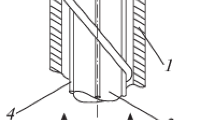Abstract
Results from systematic investigations of heat transfer and pressure drop for water flow in an annular channel using an efficient method for enhancing heat transfer on a convex heating surface are presented. The main technical data of the thermal-hydraulic experimental setup are given together with a brief description of the control, monitoring, and physical parameters measurement and recording systems, as well as primary experimental data processing and storage system. The test section, the enhancement method based on setting up swirl flows, the geometrical characteristics of intensifiers, their schematic design, and installation technology are described. The experimental data are obtained in a wide range of coolant flow parameters under the conditions of single-phase convection with using intensifiers having different shapes. The test measurements carried out on a smooth annular channel showed good agreement with the classic correlations both for heat transfer and pressure drop, thereby confirming reliability of the experimental data. A considerable improvement in heat removal efficiency on the convex heating surface is obtained. The value of heat transfer coefficient is a factor of 1.8 higher than it is for smooth annular channels. The region of the values of intensifier geometrical characteristics and Reynolds numbers for which the growth of heat transfer prevails over the growth of pressure drop is established. It is shown that the maximums of heat transfer and pressure drop are observed at quite definite values of intensifier geometrical characteristics. The primary experimental data are processed and presented as a dependence of the Nusselt number on the Reynolds number for different values of the intensifier’s relative fin height Ḣ. The value of Ḣ at which heat transfer reaches its maximum is found. The experiments were carried out in the pressure range p = 3.0–10.0 MPa and at the constant temperature of liquid at the test section inlet equal to 100°C. The influence of peripheral liquid flow swirling pitch on heat transfer and pressure drop is studied. An empirical correlation describing the dependence of heat transfer on the intensifier geometrical characteristics is obtained.
Similar content being viewed by others
References
A. I. Leont’ev and V. V. Olimpiev, “Analyzing the effectiveness of wall flow swirlers,” Therm. Eng. 60(1), 67 (2013).
I. A. Popov, A. B. Yakovlev, A. V. Shchelchkov, D. V. Ryzhkov, and L. A. Obukhova, “Prospective heat transfer enhancement methods for thermal power equipment,” Energ. Tatarst., No. 1, 25–29 (2011).
B. V. Dzyubenko, Yu. A. Kuzma-Kichta, A. I. Leont’ev, I. I. Fedik, and A. P. Kholpanov, Enhancement of Heat and Mass Transfer on Macro-, Micro-, and Nanoscales (TsNIIAtominform, Moscow, 2008) [in Russian].
Yu. Vilemas, B. Chesna, and V. Survila, Heat Transfer in Gas Cooled Annular Channels (Mokslav, Vilnius, 1977) [in Russian].
V. N. Blinkov, E. A. Boltenko, I. V. Elkin, O. I. Melikhov, and S. L. Solov’ev, “Prospects for using annular fuel elements in nuclear power engineering,” Therm. Eng. 57(3), 213 (2010).
E. A. Boltenko, “A heat transfer device,” RF Patent No. 1540426 IPC 3F28F13/12, Otkr., Izobr., No. 31 (1992).
E. A. Boltenko, “Heat transfer enhancement in steam generating channels with swirling and transit flow,” in Proceedings of the First Russian National Conference on Heat Transfer. Heat Transfer Enhancement (MEI, Moscow, 1994), Vol. 8, p. 27.
A. V. Zakharenkov, A. T. Komov, A. N. Varava, E. A. Boltenko, A. V. Dedov, V. V. Myasnikov, and A. V. Il’in, “The experimental setup for studying thermal-hydraulic characteristics of fuel assembly model elements,” Vestnik MEI, No. 2, 35–45 (2013).
A. V. Zakharenkov, A. T. Komov, E. A. Boltenko, A. N. Varava, and A. V. Dedov, “An investigation of the thermal-hydraulic characteristics of swirled single-phase flow moving in longitudinally finned annular channels,” Vestnik MEI, No. 4, 55–62 (2013).
Author information
Authors and Affiliations
Corresponding author
Additional information
Original Russian Text © E.A. Boltenko, A.N. Varava, A.V. Dedov, A.V. Zakharenkov, A.T. Komov, S.A. Malakhovskii, 2015, published in Teploenergetika.
Rights and permissions
About this article
Cite this article
Boltenko, E.A., Varava, A.N., Dedov, A.V. et al. Investigation of heat transfer and pressure drop in an annular channel with heat transfer intensifiers. Therm. Eng. 62, 177–182 (2015). https://doi.org/10.1134/S0040601515030015
Published:
Issue Date:
DOI: https://doi.org/10.1134/S0040601515030015



